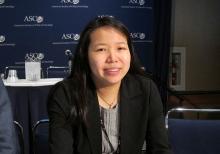Adding seribantumab to paclitaxel did not extend survival as was hoped in unselected patients with platinum-resistant or refractory ovarian cancer, according to a report published online in Journal of Clinical Oncology.
However, exploratory analyses of data from this manufacturer-sponsored open-label phase II trial showed that certain biomarkers might identify a subgroup of patients who may benefit from the addition of seribantumab, said Joyce F. Liu, MD, of Dana-Farber Cancer Institute, Boston, and her associates.
They compared outcomes among 223 patients in North America and Europe who had advanced ovarian cancer that was either resistant or refractory to platinum-based therapies. A total of 40 women received intravenous paclitaxel plus seribantumab (experimental group) and 83 received paclitaxel alone (control group).The primary endpoint, median progression-free survival (PFS) in the intention-to-treat population, was 3.75 months with seribantumab and 3.68 months without it, a nonsignificant difference. The objective response rate was actually slightly higher in the control group (18.1%) than in the experimental group (13.6%). No patient showed a complete response to treatment, the investigators said (J Clin Oncol. 2016 Oct. 26. doi: 10.1200/JCO.2016.67.1891).
Toxicities were more frequent in the experimental group, with grade 3 or higher adverse events occurring in 35.7% of the experimental group vs. 30% of the control group, serious adverse events occurring in 42.1% vs. 31.3%, and fatal adverse events occurring in 7.9% vs. 2.5%. In particular, five serious and one nonserious pulmonary embolisms developed in the experimental group, compared with only one nonserious PE in the control group.
However, the investigators also explored whether biomarkers that link directly to seribantumab’s mechanism of action would identify a subgroup of patients who might benefit from the treatment. They found that in the 57 women whose tumors expressed both detectable levels of heregulin RNA and low levels of HER2, the median PFS was 5.7 months with the addition of seribantumab, compared with only 3.5 months for paclitaxel alone. The data suggested that seribantumab acts primarily by blocking the development of resistance to treatment, rather than by inhibiting tumor growth, Dr. Liu and her associates wrote.


